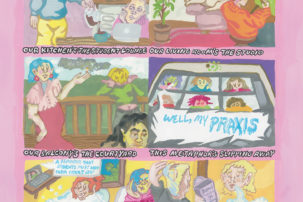Shuttered student centres. Professors and peers only seen on a screen. Empty hallways. “For lack of a better term, it’s weird,” says Ernest Zarzuela, a fourth-year studio major at the University of Manitoba’s School of Art in Winnipeg. “Art school is an environment where the teaching is fairly intimate, and a lot of it is from who you surround yourself with. The biggest thing I think about is how difficult it must be for someone starting their first year of art school in this extremely unconventional environment.” Luckily, Zarzuela has been able to keep his lab work position at U of M and, though half of his courses are online, he can use a shared studio as long as masking and sanitization protocols are met.
“We’ve been learning that creating online social spaces is just as important as being able to provide accessible education to students who either don’t live here or live in remote areas or live next door but can’t be there in person,” says Ingrid Percy, chair of Visual Arts at Memorial University’s Grenfell Campus in Corner Brook. Art professors there have opened Zoom rooms before class for student hangouts, scheduled regular one-on-one phone calls with students, rented off-campus studio space for students, and started virtual community hours for printmaking and textile studios.
At Concordia University in Montreal, student-to-student mentorships and Discord forums have helped to keep people connected. The Fine Arts Student Alliance is also using its external-events pause to address other needs: “We’ve been focusing this year on our bylaws, making amendments to work on anti-racism and addressing anti-Black racism within the university,” says Maddi Berger, FASA outreach coordinator. At the MFA level, graduate program director Erika Adams is working to ensure students maintain teaching assistant positions at a distance. “The TA-ships are key not only because of the financial benefit,” says Adams, “but also because, in my experience, I find when I have a chance to show someone else how to do something, it’s a morale boost.”
Connecting with and learning from visiting artists is central to Simon Fraser University’s School for the Contemporary Arts offerings. After Alejandro Cesarco, the Spring 2020 Audain Visual Artist in Residence, had to depart due to lockdown, he and students shifted to online, adapting the usual IRL exhibition assignment into an Instagram project and book. This past fall, the residency was adapted into the Visual Art Forum, a series of free online public lectures by artists Pablo José Ramírez, Jeremy Deller, Sandra Brewster, Irena Haiduk, Sanja Ivekovi´c, Charles Gaines, Samson Young and Tanya Lukin Linklater. Each speaker also met privately online with SFU students.
At Portage College in Alberta, work continues to ensure that Indigenous students—who comprise 40 per cent of the college’s student body—have space for cultural needs and relations. It recently moved ahead with building a permanent structure where students can smudge, to be completed in June
2021. “A lot of our students come from northern communities and are very connected to the land,” says Donna Feledichuk, dean of Paramedicine, Education, Native Arts and Trades and Technology. “We needed a venue that would allow them to maintain that connection and feel that connection.”
In lieu of in-person internships, the Innovation Acclerator, part of the Virtual Internship Program at Oakville’s Sheridan College, matched students across disciplines with a community collaborator who posed an of-the-moment problem. At term’s end, student teams pitched their co-designed solutions. “What our students are doing is providing real options for challenges that exist at a time of great change,” says Donna Braggins, associate dean of Design, Illustration and Photography.
This article is adapted from “School Guide 2021: Art education in a time of unprecedented change,” a special section of Canadian Art’s Winter 2021 print issue, “Tangents.” Download a PDF of the complete guide now, or visit our School Guide page online, to read more








